Research Report on Giotto's Virgin and Child Enthroned Artwork
VerifiedAdded on 2021/04/21
|6
|1244
|143
Report
AI Summary
This research report provides an in-depth analysis of Giotto di Bondone's artwork, Virgin and Child Enthroned, painted in 1310. The report details the artwork's general specifications, including its location in Florence and its large size (325*204 cm). It explores the artist's background, the intended viewers, and the artwork's original location in the Church of Ognissanti. The report highlights Giotto's innovative style, which broke from Byzantine traditions and introduced naturalism, influencing the Renaissance. A visual description of the artwork is provided, emphasizing the use of tempera on a wooden panel, the golden background, color combinations, and the depiction of saints and angels. The report compares the artwork with similar pieces by Cimabue and Duccio and includes a list of cited works for further reference.
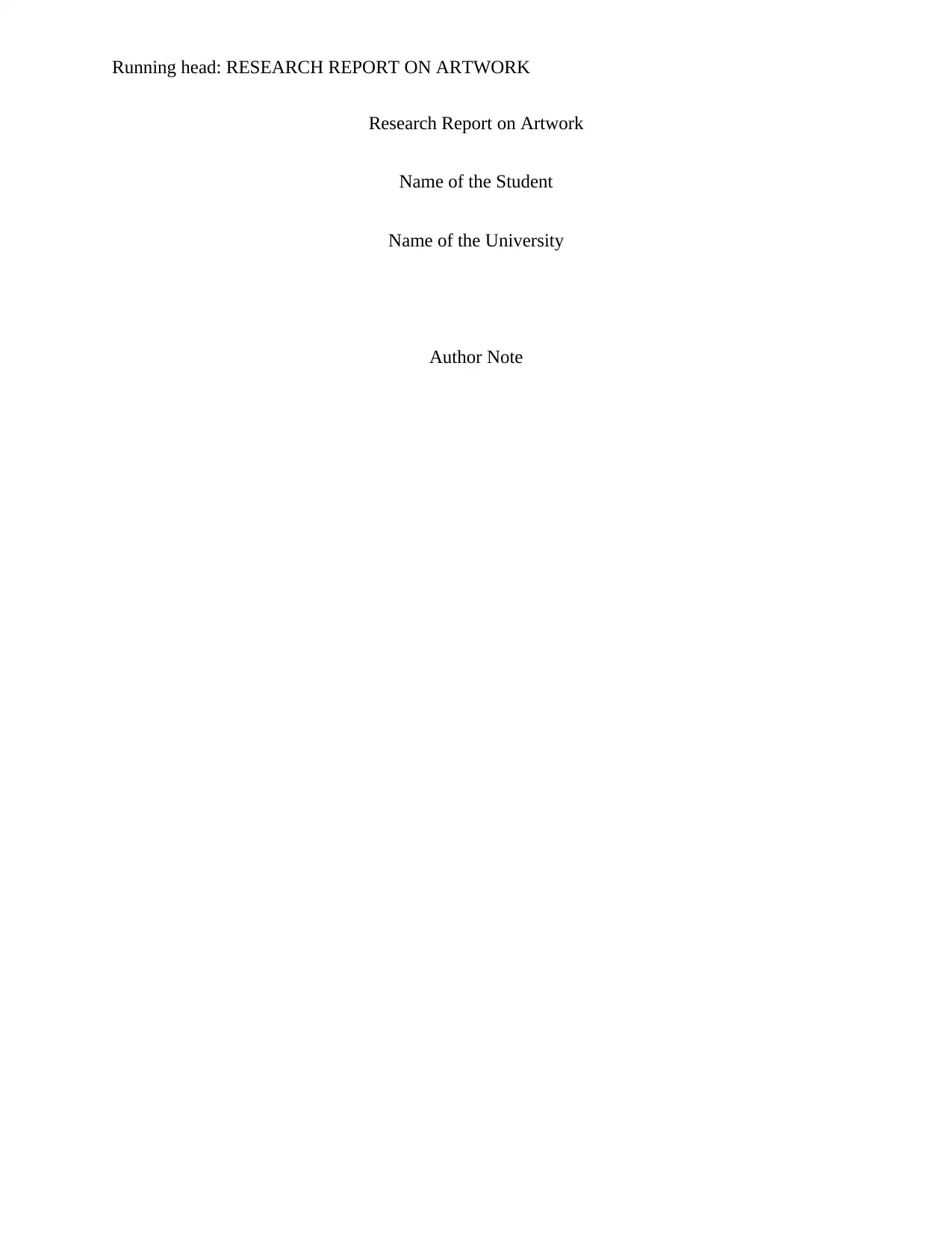
Running head: RESEARCH REPORT ON ARTWORK
Research Report on Artwork
Name of the Student
Name of the University
Author Note
Research Report on Artwork
Name of the Student
Name of the University
Author Note
Paraphrase This Document
Need a fresh take? Get an instant paraphrase of this document with our AI Paraphraser
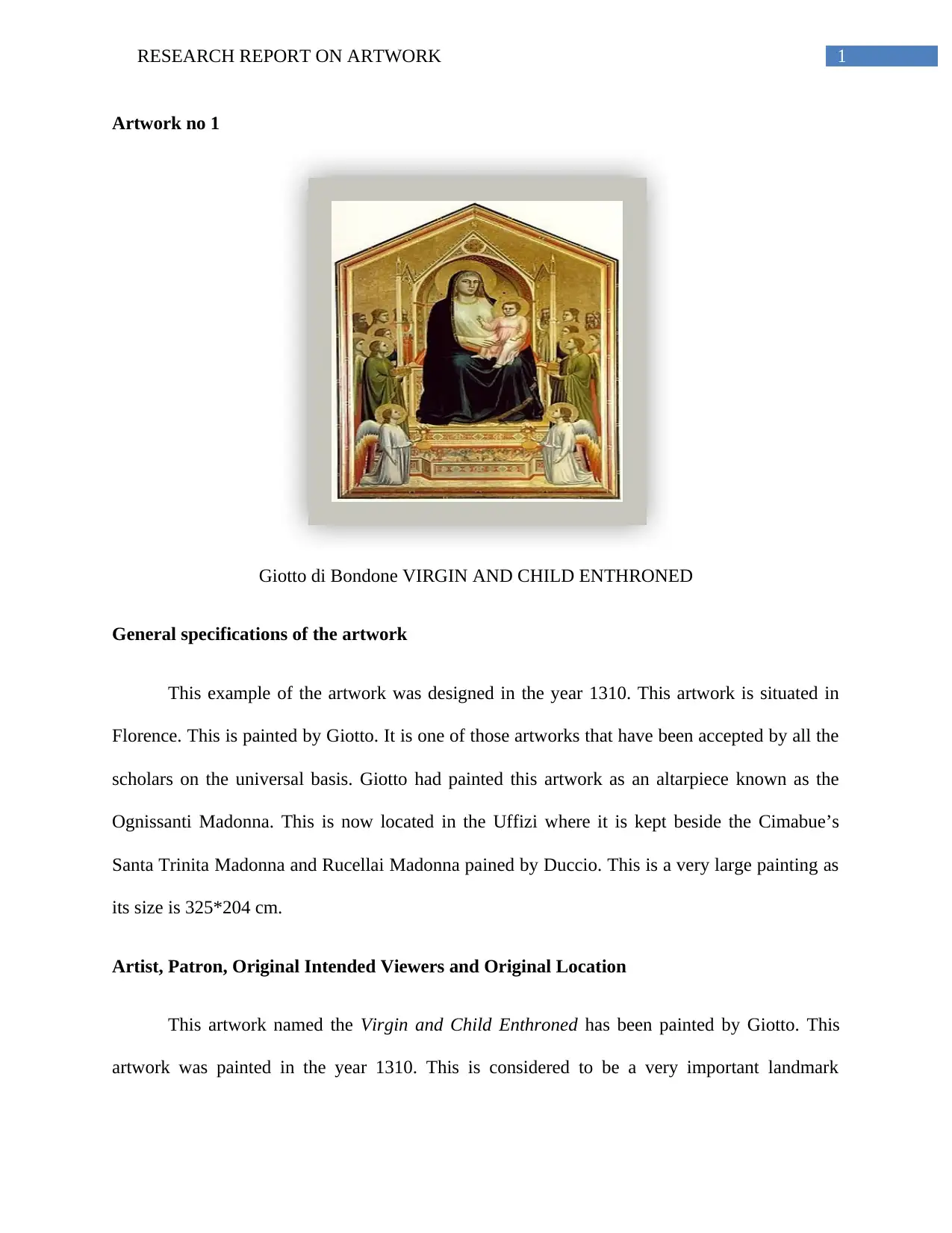
1RESEARCH REPORT ON ARTWORK
Artwork no 1
Giotto di Bondone VIRGIN AND CHILD ENTHRONED
General specifications of the artwork
This example of the artwork was designed in the year 1310. This artwork is situated in
Florence. This is painted by Giotto. It is one of those artworks that have been accepted by all the
scholars on the universal basis. Giotto had painted this artwork as an altarpiece known as the
Ognissanti Madonna. This is now located in the Uffizi where it is kept beside the Cimabue’s
Santa Trinita Madonna and Rucellai Madonna pained by Duccio. This is a very large painting as
its size is 325*204 cm.
Artist, Patron, Original Intended Viewers and Original Location
This artwork named the Virgin and Child Enthroned has been painted by Giotto. This
artwork was painted in the year 1310. This is considered to be a very important landmark
Artwork no 1
Giotto di Bondone VIRGIN AND CHILD ENTHRONED
General specifications of the artwork
This example of the artwork was designed in the year 1310. This artwork is situated in
Florence. This is painted by Giotto. It is one of those artworks that have been accepted by all the
scholars on the universal basis. Giotto had painted this artwork as an altarpiece known as the
Ognissanti Madonna. This is now located in the Uffizi where it is kept beside the Cimabue’s
Santa Trinita Madonna and Rucellai Madonna pained by Duccio. This is a very large painting as
its size is 325*204 cm.
Artist, Patron, Original Intended Viewers and Original Location
This artwork named the Virgin and Child Enthroned has been painted by Giotto. This
artwork was painted in the year 1310. This is considered to be a very important landmark
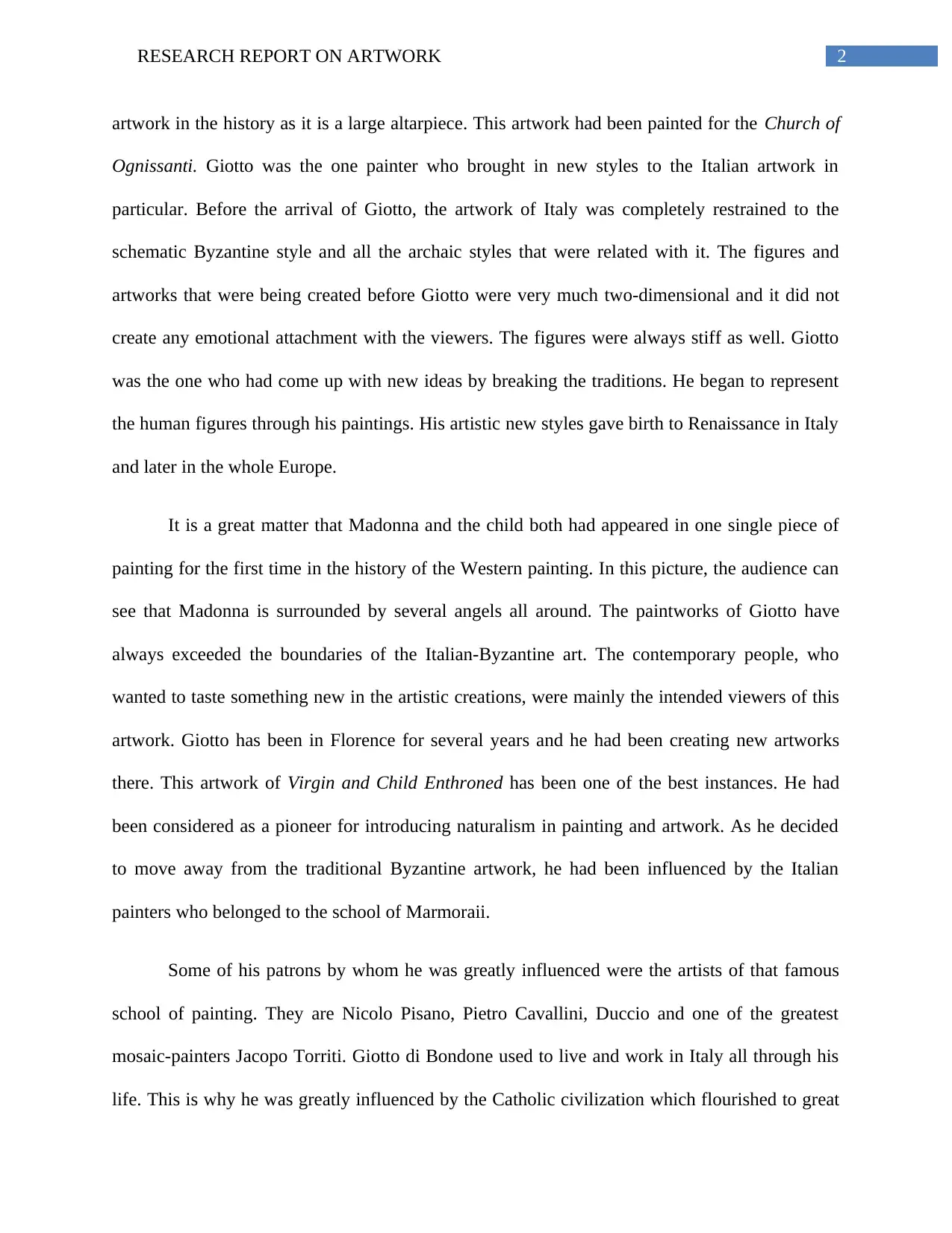
2RESEARCH REPORT ON ARTWORK
artwork in the history as it is a large altarpiece. This artwork had been painted for the Church of
Ognissanti. Giotto was the one painter who brought in new styles to the Italian artwork in
particular. Before the arrival of Giotto, the artwork of Italy was completely restrained to the
schematic Byzantine style and all the archaic styles that were related with it. The figures and
artworks that were being created before Giotto were very much two-dimensional and it did not
create any emotional attachment with the viewers. The figures were always stiff as well. Giotto
was the one who had come up with new ideas by breaking the traditions. He began to represent
the human figures through his paintings. His artistic new styles gave birth to Renaissance in Italy
and later in the whole Europe.
It is a great matter that Madonna and the child both had appeared in one single piece of
painting for the first time in the history of the Western painting. In this picture, the audience can
see that Madonna is surrounded by several angels all around. The paintworks of Giotto have
always exceeded the boundaries of the Italian-Byzantine art. The contemporary people, who
wanted to taste something new in the artistic creations, were mainly the intended viewers of this
artwork. Giotto has been in Florence for several years and he had been creating new artworks
there. This artwork of Virgin and Child Enthroned has been one of the best instances. He had
been considered as a pioneer for introducing naturalism in painting and artwork. As he decided
to move away from the traditional Byzantine artwork, he had been influenced by the Italian
painters who belonged to the school of Marmoraii.
Some of his patrons by whom he was greatly influenced were the artists of that famous
school of painting. They are Nicolo Pisano, Pietro Cavallini, Duccio and one of the greatest
mosaic-painters Jacopo Torriti. Giotto di Bondone used to live and work in Italy all through his
life. This is why he was greatly influenced by the Catholic civilization which flourished to great
artwork in the history as it is a large altarpiece. This artwork had been painted for the Church of
Ognissanti. Giotto was the one painter who brought in new styles to the Italian artwork in
particular. Before the arrival of Giotto, the artwork of Italy was completely restrained to the
schematic Byzantine style and all the archaic styles that were related with it. The figures and
artworks that were being created before Giotto were very much two-dimensional and it did not
create any emotional attachment with the viewers. The figures were always stiff as well. Giotto
was the one who had come up with new ideas by breaking the traditions. He began to represent
the human figures through his paintings. His artistic new styles gave birth to Renaissance in Italy
and later in the whole Europe.
It is a great matter that Madonna and the child both had appeared in one single piece of
painting for the first time in the history of the Western painting. In this picture, the audience can
see that Madonna is surrounded by several angels all around. The paintworks of Giotto have
always exceeded the boundaries of the Italian-Byzantine art. The contemporary people, who
wanted to taste something new in the artistic creations, were mainly the intended viewers of this
artwork. Giotto has been in Florence for several years and he had been creating new artworks
there. This artwork of Virgin and Child Enthroned has been one of the best instances. He had
been considered as a pioneer for introducing naturalism in painting and artwork. As he decided
to move away from the traditional Byzantine artwork, he had been influenced by the Italian
painters who belonged to the school of Marmoraii.
Some of his patrons by whom he was greatly influenced were the artists of that famous
school of painting. They are Nicolo Pisano, Pietro Cavallini, Duccio and one of the greatest
mosaic-painters Jacopo Torriti. Giotto di Bondone used to live and work in Italy all through his
life. This is why he was greatly influenced by the Catholic civilization which flourished to great
⊘ This is a preview!⊘
Do you want full access?
Subscribe today to unlock all pages.

Trusted by 1+ million students worldwide
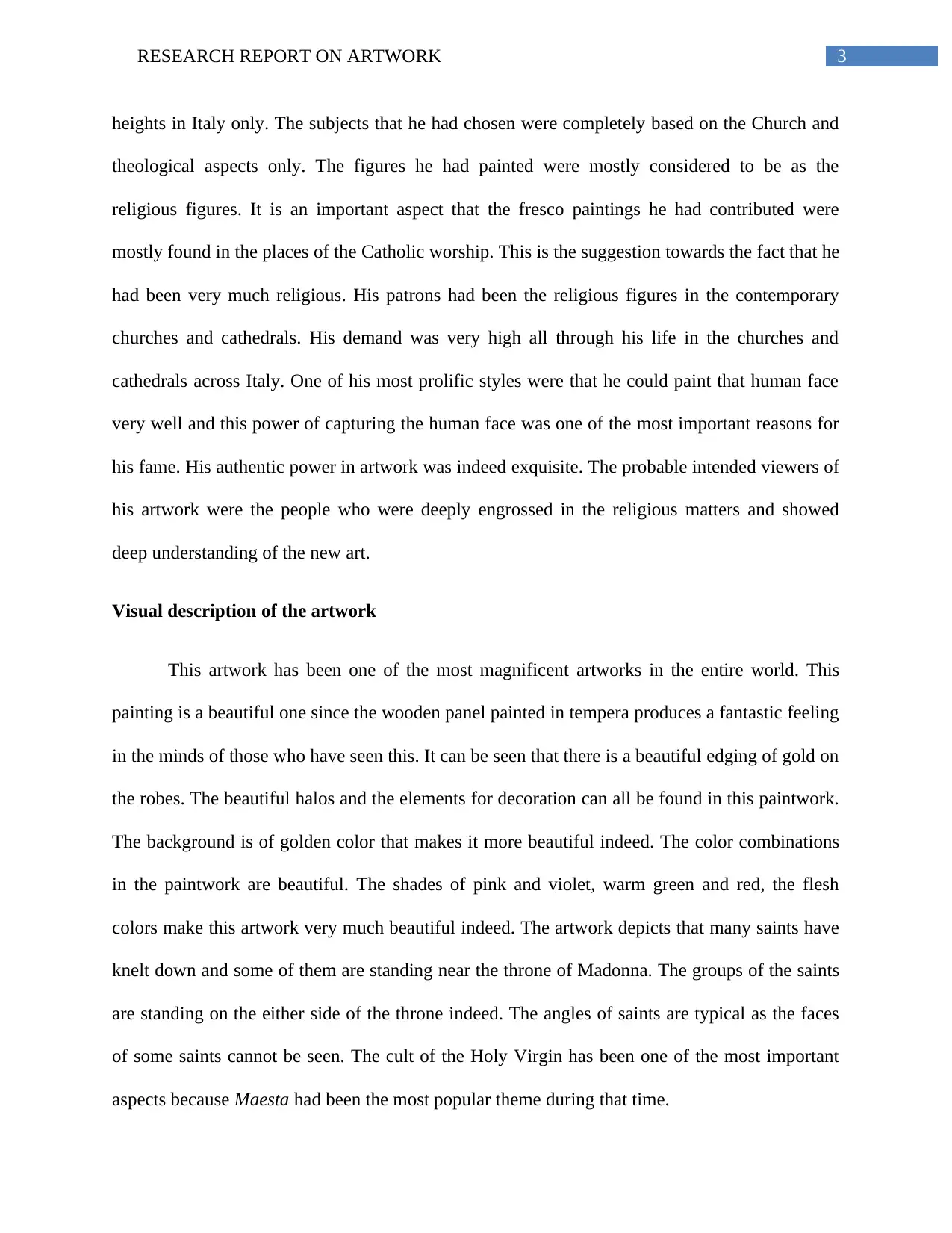
3RESEARCH REPORT ON ARTWORK
heights in Italy only. The subjects that he had chosen were completely based on the Church and
theological aspects only. The figures he had painted were mostly considered to be as the
religious figures. It is an important aspect that the fresco paintings he had contributed were
mostly found in the places of the Catholic worship. This is the suggestion towards the fact that he
had been very much religious. His patrons had been the religious figures in the contemporary
churches and cathedrals. His demand was very high all through his life in the churches and
cathedrals across Italy. One of his most prolific styles were that he could paint that human face
very well and this power of capturing the human face was one of the most important reasons for
his fame. His authentic power in artwork was indeed exquisite. The probable intended viewers of
his artwork were the people who were deeply engrossed in the religious matters and showed
deep understanding of the new art.
Visual description of the artwork
This artwork has been one of the most magnificent artworks in the entire world. This
painting is a beautiful one since the wooden panel painted in tempera produces a fantastic feeling
in the minds of those who have seen this. It can be seen that there is a beautiful edging of gold on
the robes. The beautiful halos and the elements for decoration can all be found in this paintwork.
The background is of golden color that makes it more beautiful indeed. The color combinations
in the paintwork are beautiful. The shades of pink and violet, warm green and red, the flesh
colors make this artwork very much beautiful indeed. The artwork depicts that many saints have
knelt down and some of them are standing near the throne of Madonna. The groups of the saints
are standing on the either side of the throne indeed. The angles of saints are typical as the faces
of some saints cannot be seen. The cult of the Holy Virgin has been one of the most important
aspects because Maesta had been the most popular theme during that time.
heights in Italy only. The subjects that he had chosen were completely based on the Church and
theological aspects only. The figures he had painted were mostly considered to be as the
religious figures. It is an important aspect that the fresco paintings he had contributed were
mostly found in the places of the Catholic worship. This is the suggestion towards the fact that he
had been very much religious. His patrons had been the religious figures in the contemporary
churches and cathedrals. His demand was very high all through his life in the churches and
cathedrals across Italy. One of his most prolific styles were that he could paint that human face
very well and this power of capturing the human face was one of the most important reasons for
his fame. His authentic power in artwork was indeed exquisite. The probable intended viewers of
his artwork were the people who were deeply engrossed in the religious matters and showed
deep understanding of the new art.
Visual description of the artwork
This artwork has been one of the most magnificent artworks in the entire world. This
painting is a beautiful one since the wooden panel painted in tempera produces a fantastic feeling
in the minds of those who have seen this. It can be seen that there is a beautiful edging of gold on
the robes. The beautiful halos and the elements for decoration can all be found in this paintwork.
The background is of golden color that makes it more beautiful indeed. The color combinations
in the paintwork are beautiful. The shades of pink and violet, warm green and red, the flesh
colors make this artwork very much beautiful indeed. The artwork depicts that many saints have
knelt down and some of them are standing near the throne of Madonna. The groups of the saints
are standing on the either side of the throne indeed. The angles of saints are typical as the faces
of some saints cannot be seen. The cult of the Holy Virgin has been one of the most important
aspects because Maesta had been the most popular theme during that time.
Paraphrase This Document
Need a fresh take? Get an instant paraphrase of this document with our AI Paraphraser
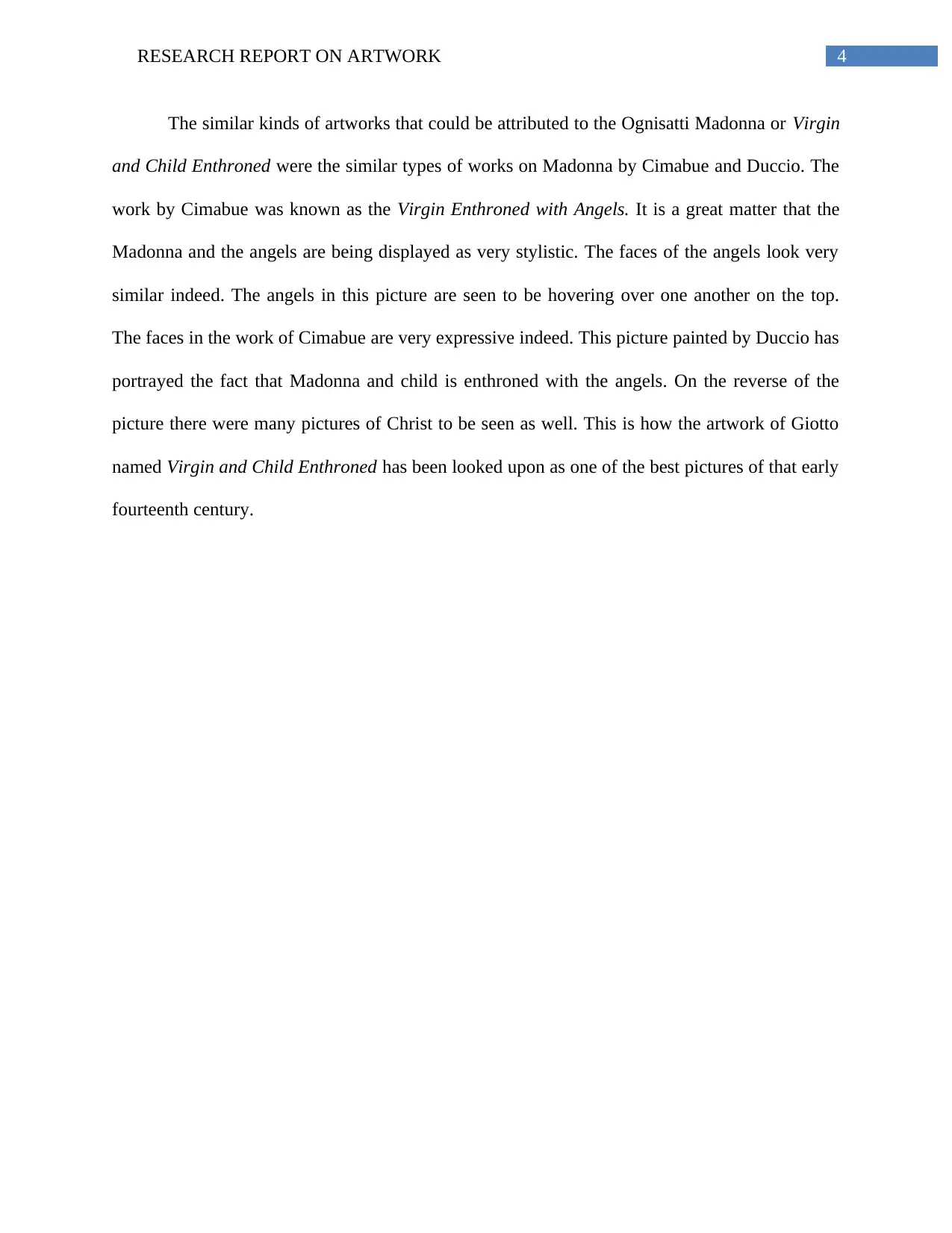
4RESEARCH REPORT ON ARTWORK
The similar kinds of artworks that could be attributed to the Ognisatti Madonna or Virgin
and Child Enthroned were the similar types of works on Madonna by Cimabue and Duccio. The
work by Cimabue was known as the Virgin Enthroned with Angels. It is a great matter that the
Madonna and the angels are being displayed as very stylistic. The faces of the angels look very
similar indeed. The angels in this picture are seen to be hovering over one another on the top.
The faces in the work of Cimabue are very expressive indeed. This picture painted by Duccio has
portrayed the fact that Madonna and child is enthroned with the angels. On the reverse of the
picture there were many pictures of Christ to be seen as well. This is how the artwork of Giotto
named Virgin and Child Enthroned has been looked upon as one of the best pictures of that early
fourteenth century.
The similar kinds of artworks that could be attributed to the Ognisatti Madonna or Virgin
and Child Enthroned were the similar types of works on Madonna by Cimabue and Duccio. The
work by Cimabue was known as the Virgin Enthroned with Angels. It is a great matter that the
Madonna and the angels are being displayed as very stylistic. The faces of the angels look very
similar indeed. The angels in this picture are seen to be hovering over one another on the top.
The faces in the work of Cimabue are very expressive indeed. This picture painted by Duccio has
portrayed the fact that Madonna and child is enthroned with the angels. On the reverse of the
picture there were many pictures of Christ to be seen as well. This is how the artwork of Giotto
named Virgin and Child Enthroned has been looked upon as one of the best pictures of that early
fourteenth century.
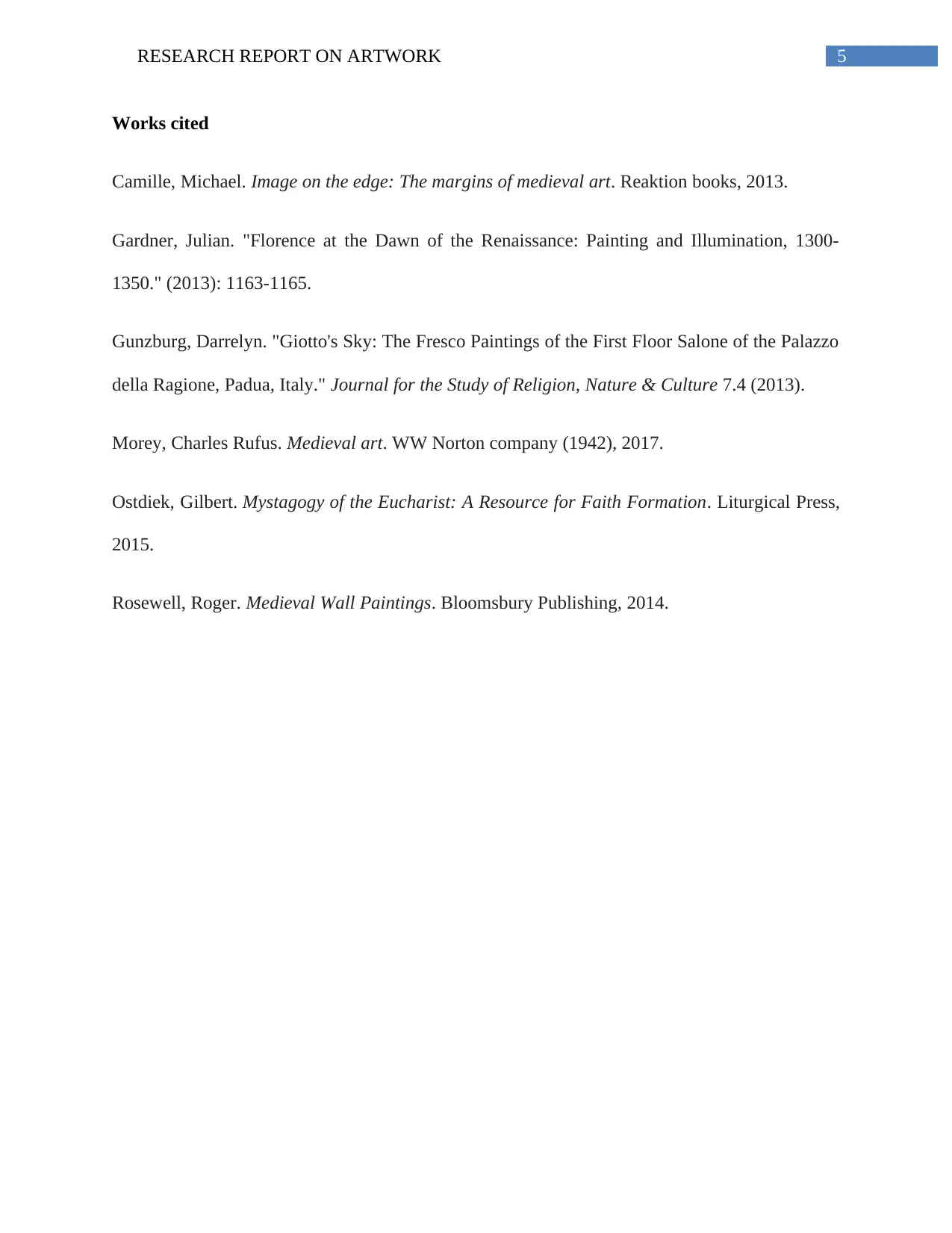
5RESEARCH REPORT ON ARTWORK
Works cited
Camille, Michael. Image on the edge: The margins of medieval art. Reaktion books, 2013.
Gardner, Julian. "Florence at the Dawn of the Renaissance: Painting and Illumination, 1300-
1350." (2013): 1163-1165.
Gunzburg, Darrelyn. "Giotto's Sky: The Fresco Paintings of the First Floor Salone of the Palazzo
della Ragione, Padua, Italy." Journal for the Study of Religion, Nature & Culture 7.4 (2013).
Morey, Charles Rufus. Medieval art. WW Norton company (1942), 2017.
Ostdiek, Gilbert. Mystagogy of the Eucharist: A Resource for Faith Formation. Liturgical Press,
2015.
Rosewell, Roger. Medieval Wall Paintings. Bloomsbury Publishing, 2014.
Works cited
Camille, Michael. Image on the edge: The margins of medieval art. Reaktion books, 2013.
Gardner, Julian. "Florence at the Dawn of the Renaissance: Painting and Illumination, 1300-
1350." (2013): 1163-1165.
Gunzburg, Darrelyn. "Giotto's Sky: The Fresco Paintings of the First Floor Salone of the Palazzo
della Ragione, Padua, Italy." Journal for the Study of Religion, Nature & Culture 7.4 (2013).
Morey, Charles Rufus. Medieval art. WW Norton company (1942), 2017.
Ostdiek, Gilbert. Mystagogy of the Eucharist: A Resource for Faith Formation. Liturgical Press,
2015.
Rosewell, Roger. Medieval Wall Paintings. Bloomsbury Publishing, 2014.
⊘ This is a preview!⊘
Do you want full access?
Subscribe today to unlock all pages.

Trusted by 1+ million students worldwide
1 out of 6
Related Documents
Your All-in-One AI-Powered Toolkit for Academic Success.
+13062052269
info@desklib.com
Available 24*7 on WhatsApp / Email
![[object Object]](/_next/static/media/star-bottom.7253800d.svg)
Unlock your academic potential
Copyright © 2020–2025 A2Z Services. All Rights Reserved. Developed and managed by ZUCOL.





